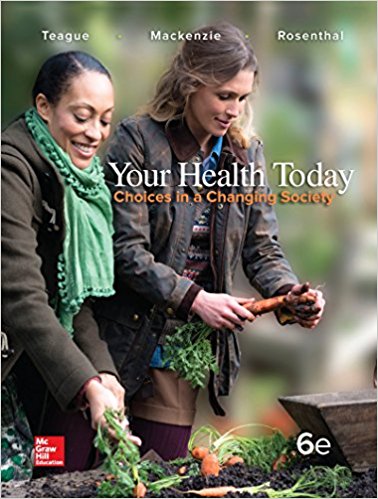In Stock
Your Health Today Choices in a Changing Society, 6th Edition Test Bank
Digital item No Waiting Time Instant DownloadISBN-13: 978-1259423284 ISBN-10: 125942328XAuthor: Michael Teague Sara Mackenzie David RosenthalPublisher : McGraw Hill
Original price was: $55.00.$22.00Current price is: $22.00.
Your Health Today Choices in a Changing Society, 6th Edition Test Bank
Chapter 1 – Self, Family, and Community
Multiple-Choice Questions
1. Which of the following describes the process in which one adopts patterns of behavior that lead to greater life satisfaction?
A. wellness
B. health
C. social determination
D. self-efficacy
Answer: A
Page(s): 2
Bloom’s: Remember
Topic: Your Health in Context
Learning Objective: Demonstrate a basic understanding of common health terminology.
2. Which of the following is considered a social determinant of health?
A. heredity
B. employment status
C. your values
D. the physical environment
Answer: B
Page(s): 4
Bloom’s: Remember
Topic: Your Health in Context
Learning Objective: Demonstrate a basic understanding of common health terminology.
3. According to the socioecological model of health and wellness, which of the following is a factor in a person’s natural physical environment?
A. air quality
B. sanitation systems
C. access to health care services
D. housing
Answer: A
Page(s) : 4
Bloom’s: Remember
Topic: Your Health in Context
Learning Objective: Demonstrate a basic understanding of common health terminology.
4. Which of the following best demonstrates a socioecological model of health and wellness?
A. seeking a natural balance between your own life forces and those in your environment
B. being aware of hereditary risks and avoiding unhealthy environments and behaviors
C. going to the doctor whenever you suspect an illness
D. seeking nontraditional medical treatments
Answer: B
Page(s): 3
Bloom’s: Understand
Topic: Your Health in Context
Learning Objective: Demonstrate a basic understanding of common health terminology.
5. Which of the following statements about cells and genes is FALSE?
A. The sequencing of bases within a gene is of little significance.
B. Each cell contains 23 pairs of chromosomes.
C. Our bodies are made up of about 260 different types of cells.
D. Each chromosome contains from hundreds to thousands of genes.
Answer: A
Page(s): 16
Bloom’s: Remember
Topic: Your Health and Your Family Health History
Learning Objective: Explain how factors such as family health history or genetics can influence a person’s patterns of health and illness.
6. Deoxyribonucleic acid, or DNA, includes which of the following?
A. a triple helix
B. proteins
C. a nucleus
D. four bases
Answer: D
Page(s): 15
Bloom’s: Remember
Topic: Your Health and Your Family Health History
Learning Objective: Explain how factors such as family health history or genetics can influence a person’s patterns of health and illness.
7. When a change occurs in a gene, it is called
A. a recessive gene.
B. an allele.
C. a mutation.
D. a chromosomal disorder.
Answer: C
Page(s): 17
Bloom’s: Remember
Topic: Your Health and Your Family Health History
Learning Objective: Explain how factors such as family health history or genetics can influence a person’s patterns of health and illness.
8. Alternative forms of the same gene are called
A. recessive genes.
B. alleles.
C. mutations.
D. chromosomes.
Answer: B
Page(s): 17
Bloom’s: Remember
Topic: Your Health and Your Family Health History
Learning Objective: Explain how factors such as family health history or genetics can influence a person’s patterns of health and illness.
9. Genetic disorders caused by multiple genes interacting with the environment are called
A. polygenic.
B. autosomal.
C. ecological.
D. multifactorial.
Answer: D
Page(s): 17
Bloom’s: Remember
Topic: Your Health and Your Family Health History
Learning Objective: Explain how factors such as family health history or genetics can influence a person’s patterns of health and illness.
10. Heart disease is an example of a multifactorial illness. Which of the following does NOT support this statement?
A. Both smoking tobacco and having high blood pressure increase the risk for heart disease.
B. First-degree relatives have a six-fold increase in their risk for heart disease.
C. Genetic screening and information may lead an individual to modify his or her environmental risk factors to prevent the disease from developing.
D. Random error in the formation of ovum or sperm causes heart disease.
Answer: D
Page(s): 17
Bloom’s: Apply
Topic: Your Health and Your Family Health History
Learning Objective: Explain how factors such as family health history or genetics can influence a person’s patterns of health and illness.

Rodney Stanford –
thanks to have it